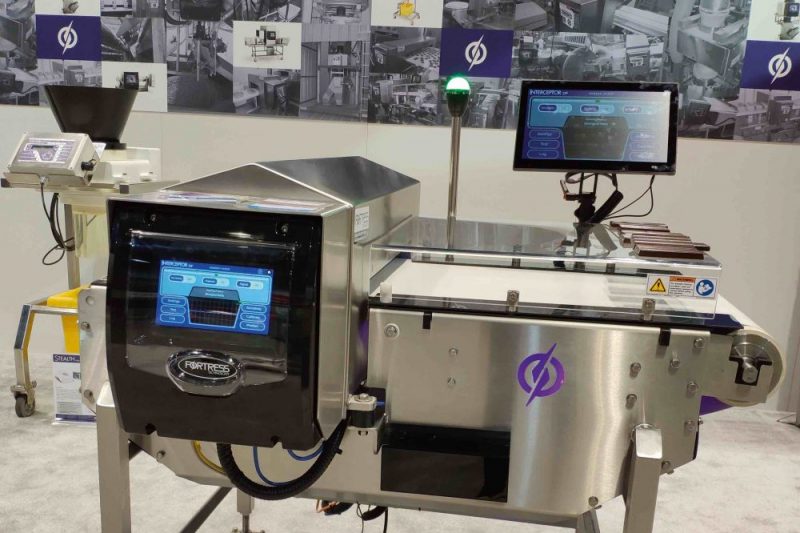Automation, inspection and sorting systems making their mark on industry

Tony McDonald, sales and marketing director of Ilapak UK, examines automation in inspection and production facilities, and we also cast our eye over sorting equipment developments from Fortress and Tomra
While the use of robotics and automation in the UK food and drink industry has been steadily growing over the past decade, Britain is still lagging behind many of its international counterparts.
As the lowest G7 nation, UK sits 22nd in the world robot league table with just 71 robots per 10,000 workers, behind nations such as Slovenia (137), Sweden (223), and South Korea (631). This could be about to change, however, as an unlikely source is set to herald a long-awaited robot revolution in food production.
One of the main barriers to greater uptake of automation, particularly amongst SMEs, is the cost of unskilled labour versus investment in robotics technology. Thanks to the EU’s free movement of workers, Britain’s food and drink industry has benefitted from cheap labour for a number of years – in fact, it employs the highest share of EU migrant workers (30 per cent) compared with any other UK sector, employing around one fifth of the two million EU nationals working in Britain. This figure is at its highest on fruit and vegetable farms, where 99 per cent of workers come from Eastern Europe.
But Brexit is set to change the labour landscape in just a few short years. The Food and Drink Federation (FDF) reported that 47 per cent of companies in Britain’s food supply chain said their EU workers were considering their future as a direct result of the June 2016 Brexit vote. On farms the impact is starker still – according to the National Farmers’ Union, in the crucial harvest month of September 2017, 29 per cent of roles went unfilled, the first shortfall since records began back in 2014.
Brexit, combined with a skills shortage brought about an ageing domestic workforce and a lack of British young people coming into the industry – not to mention the 2020 deadline for the new National Minimum Wage – is giving the UK’s food and drink businesses a staffing dilemma. Faced with an impending lack of comparatively low cost labour, many are turning to robots to fill the gap.
Using automation for repetitive or dangerous tasks protects the remaining workforce, leaving employees free to be upskilled and take on safer and more rewarding roles. Far from replacing all human employees, robots can actually help to increase staff retention levels.
An end to foreign objects
As well as speeding up the production process and improving job satisfaction among human employees, the use of robots can also help to reduce contamination; a key target for any food business.
A lot of food manufacturers have been running flow wrappers for years, but use staff to manually load them. They might have a belt with a high volume of products along it and four or five people on each flow wrapper picking up the products and feeding the machine. Ilapak has introduced robots to stack products and organise them in batches of two, three or four, then use a multi-belt system to feed them into the machine.
Within that process servo–drive belts can be programmed to split the products up into exactly what is required. Robots can also be used after flow wrapping to stack and pack a product before placing the packs into retail trays. Removing the human element from the process removes the risk of contamination, which in turn helps to extend a product’s shelf life.
Food inspection first
For its part, Fortress Technology has launched what is believes is a food inspection world breakthrough – a metal detector that inspects low profile, high value products vertically and horizontally concurrently to achieve high levels of sensitivity.
The Interceptor DF (Divergent Field) is a result of the company’s longstanding expertise in metal detection and its more recent development of the two-channel, two frequency Interceptor range.
“The ability to choose the direction of the inspection field is itself ground-breaking,” says Fortress European Managing Director Phil Brown. “Performance wise, nothing else on the market comes close to the Interceptor DF when looking for thin, non-spherical metal contaminants in products,” claims Phil.
Believed to be the first ever multi-orientation, multi-scan food metal detector, the Interceptor DF is especially sensitive to very thin metal contaminant flakes and foils that are difficult to detect on low profile foods, including chocolate, confectionery, nutrition bars, cookies and biscuits. The Interceptor DF can also be used to inspect small thin packages of conductive products like cheese and deli-meats with a high value and high market image, for example steak burgers, Parma ham and Parmesan cheese.
Rather than scanning a select number of frequencies, the conveyor-style metal detector inspects raw, cooked and packaged products using multiple field directions.
To increase food safety, the Interceptor DF system addresses several previous limitations – notably orientation, size, geometry and position of metals. It’s especially reliable at detecting very thin flakes and foils that could be introduced to premium foods in the mixing, rolling, cooking, scoring, moulding, slicing or baking processes.
Different to other multi-scan metal detectors on the market, the unique Fortress system uses multiple coil sets to instantaneously drive the electromagnetic fields in different directions. Rather than missing a metal contaminant because it hasn’t aligned with a specific field, the Interceptor DF looks for signals over a broad spectrum, from multiple angles.
The stronger disturbance from one field compensates for the weaker signal from another. This increases the probability of identifying and rejecting products containing non-spherical metals by over 100%, including difficult to spot flat metal flakes.
Sorting success
Meanwhile, UK confectionery business Swizzels Matlow, has reported that it has selected Tomra’s Nimbus optical sorter to automate the sorting process of its ‘Drumstick Squashies’ in order to meet growing demand for the range.
The brand is one of the longest-running sugar confectionery factories in the world, having celebrated its 90th anniversary in 2018. They produce much-loved heritage brands, such as the iconic ‘Love Hearts’, as well as new innovations.
The factory, based in Derbyshire, employs more than 500 people and covers over 20,000 square metres. In 2018, it produced 20,000 tonnes of Love Hearts, Refreshers, Drumstick Lollies, Double Lollies, Parma Violets, Rainbow Drops and Drumstick Squashies.As the company explained, it has selected Tomra’s Nimbus optical sorter to handle the delicate sorting operation of their ‘Drumstick Squashies’, whose growing popularity has led to a fast increase in demand: “We used manual labour to remove any imperfect sweets that may have been created during the process.
Our desire to provide only product of the highest quality to our consumers drove us to seek an alternative solution to manual sorting in order to improve the effectiveness whilst also delivering cost benefits to the business,” explains Matt Whatcott, business unit manager (Jellies) at Swizzels Matlow.



